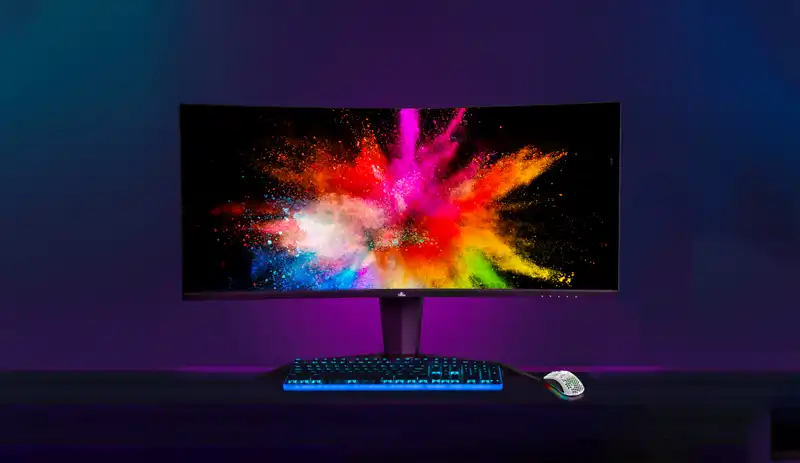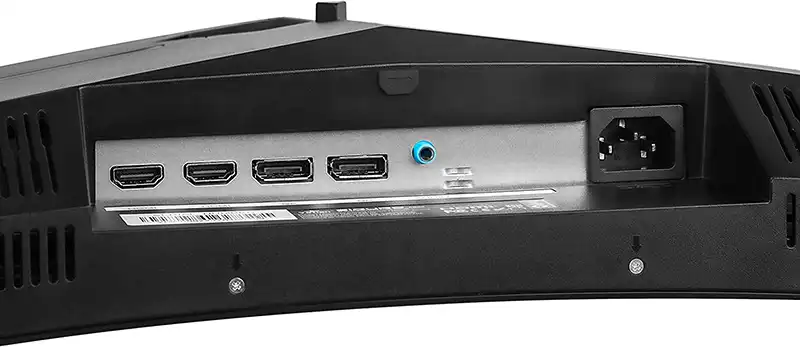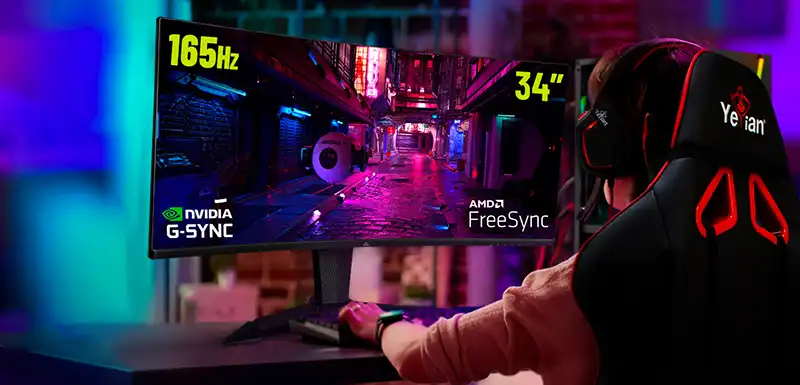You can also be interested in these:
- ViewSonic VX2458 gaming monitor review
- ViewSonic Elite XG271QG gaming monitor review
- KTC M27P20P 4K Mini-LED gaming monitor review
- All about the Nvidia G-Sync technology
Today, we are introducing the Yeyian Sigurd 4000 gaming monitor, which aims to offer the most affordable unit in its class. To achieve this, the brand has opted for a 34″ 21:9 LCD VA panel with a 1500R curvature, providing both immersion and width. However, what sets this monitor apart is its 165 Hz refresh rate with Adaptive Sync, 1 ms response time, and game-specific settings. The calibration of the monitor can be excellent with a colorimeter, which we will demonstrate. The monitor also has a pleasing aesthetic with back LED lighting, which completes the package.
Design and exterior constitution
The Yeyian Sigurd 4000 presents a well-designed and aesthetically pleasing gaming monitor. However, the most crucial aspect for us is its construction and stability, especially for a monitor of this size. Inexpensive monitors usually require improvements in this area; will the same be true for this monitor?

Let’s begin by examining the floor support base, which consists of two long legs positioned in a “V” shape with central support and expanded ends. They protrude slightly from the vertical plane formed by the monitor, but do not obstruct keyboard use. The construction is primarily aluminum with plastic ends. In the central circle, there is a coupling anchoring system for the arm and a manually threaded screw for fixation.
The monitor’s arm is also made of metal for the internal chassis, while the external covers are made of plastic with an aggressive polygonal design in matte black. At the top, there is a small handle for carrying the monitor, and just below it, there is a support for hanging something, but there is no hole for cable routing. The plastic covers are attached by screws from the outside, negatively affecting the overall aesthetic.
The monitor’s mounting mechanism is somewhat unusual since it is not square like most monitors, but it does support VESA 75×75 mm anchors (adapters included). It consists of a hexagonal head with a quick coupling at the back, which is secured to the support arm by two screws. The arm, in turn, forms a hinge for horizontal adjustment of the screen. Although it works, the attachment to the screen is not as firm as it should be, and the arm attachment is susceptible to screws loosening after extended use. We believe that a more standard system would have yielded better results.
Once the monitor is fully assembled and positioned in front of us, we see ultra-thin screen borders, which are now standard in PC monitors. The thicknesses we have are 9mm for the side and top borders, which are partially integrated into the image panel, and 17mm for the plastic lower edge, which is well attached to the screen. The only relevant element is the OSD button panel in the lower-right corner. The manufacturing quality and finishes are quite good, which is excellent news for a curved monitor like this.

Moving to the back, we have the rigid plastic cover with three star-shaped lighting zones, which are merely an aesthetic feature with basic customization options available from the OSD. There are ventilation grilles on the edges on each side of the port panel, but they should not be confused with speaker outlets since this unit does not have speakers.
Ergonomics
Let’s take a closer look at the ergonomics of the Yeyian Sigurd 4000, which is quite good for its large size. The arm’s hydraulic mechanism provides an 85mm height adjustment, which may not be the widest range, but it is sufficient for proper adjustment on a desk or chair.
The base-arm joint has a vertical orientation swivel mechanism, with a range of about 60 degrees to the right and left. The support hinge provides horizontal adjustment in a range of -5 degrees downwards and 15 degrees upwards.
Connection ports
Let’s take a look at the port configuration, located in the lower area facing the ground:
- 2x HDMI 2.0b
- 2x DisplayPort 1.4a
- 1x 3.5 mm combo audio jack

In this case, there are no USB ports or USB-C video to offer more possibilities for laptops. However, there are PIP/PBP (Picture In Picture / Picture By Picture) modes available, which allow us to view two image sources simultaneously on the same monitor. This feature improves professional workflows and designs.
The DisplayPort supports the native 3440x1400p resolution at 165 Hz, while HDMI is limited to 100 Hz, so please keep this in mind.
Display and screen panel capabilities
The Yeyian Sigurd 4000 joins the exclusive club of Ultra Wide monitors with a focus on entertainment and gaming. It combines a 34″ 21:9 panel with a 1500R curvature, which is considered perfect for covering our field of vision. The native resolution of 3440x1440p provides a sharp image for enjoying all types of content.
With this curvature, the obvious choice is an LCD VA panel, which provides a refresh rate of 165 Hz with Adaptive Sync technology compatible with G-Sync, as verified. The minimum response time in MPRT mode is 1 ms. This mode may generate some flickering, although with such a high refresh rate, our eyes may not notice it. We did not see any options to adjust Overdrive in the settings.
The Yeyian Sigurd 4000 has Flicker-Free technology, an Anti-Glare panel, and Low Blue Light technology to protect eyes from blue light. It has multiple predefined image modes for enhancing the gaming experience, such as FPS or RTS, as well as on-screen crosshairs, dynamic lighting control, and an automatic HDR mode that can be activated from the OSD.

The panel manufacturer is unknown, but it seems that the out-of-the-box calibration is not particularly impressive. Its basic features include a typical contrast ratio of 3000:1, a maximum brightness of 400 nits with HDR Ready, and an 8-bit color depth offering 121% sRGB and 85% NTSC. The viewing angles are 178 degrees and appear to be adequately met, although we may lose a little brightness and contrast if we place ourselves too close to the sides.
OSD panel
We access the OSD panel through the buttons located in the lower right corner, which provide shortcuts for on-screen crosshairs, Eco mode, and color mode.
The main panel is not particularly attractive, but it serves its purpose. There are two basic menus initially, and the third menu contains interesting options such as image modes, color temperature, and Low Blue Light. The next menu offers the MPRT mode and other filter settings to adjust the image to our liking, although we consider that the default settings are correct.
In the display settings, we find the aspect ratio and basic control of the backlighting. We will have the PIP and PBP modes in a dedicated section where we can adjust the inputs, size, and position of the windows. Moving from the typical OSD presentation settings, we go to the last section where we can activate Adaptive Sync and HDR mode.
Final words about the Yeyian Sigurd 4000 gaming monitor
Yeyian is continuing its upward trajectory in terms of building gaming monitors, expanding its catalog with options as good and exclusive as this ultra-wide curved monitor. The best part is that it opts for panels with good quality and performance while maximizing its price to be consistently ranked in the top 1 or 2 of the cheapest monitors.
The most remarkable features of this unit, in addition to its format, are choosing a very good VA panel with competitive level gaming image quality and performance at 165 Hz and 1 ms response time, albeit with a little ghosting. The feeling of immersion is excellent both in games and multimedia content, with the advantage of not seeing black bars in movies – a great experience on its 34-inch screen!
The external aesthetics are decent, although with such a competitively priced monitor, it is expected to see some cuts in the support section, which may not feel as robust and stable as more expensive models. It does not have built-in speakers or USB-C or USB ports, and the HDMI will be limited to 100 Hz due to its version. The out-of-the-box panel calibration is not very impressive, but this can be easily fixed by using the provided ICC profile and calibration parameters to achieve high-end figures.
More stories like this
- ViewSonic VX2458 gaming monitor review
- ViewSonic Elite XG271QG gaming monitor review
- KTC M27P20P 4K Mini-LED gaming monitor review
- All about the Nvidia G-Sync technology
